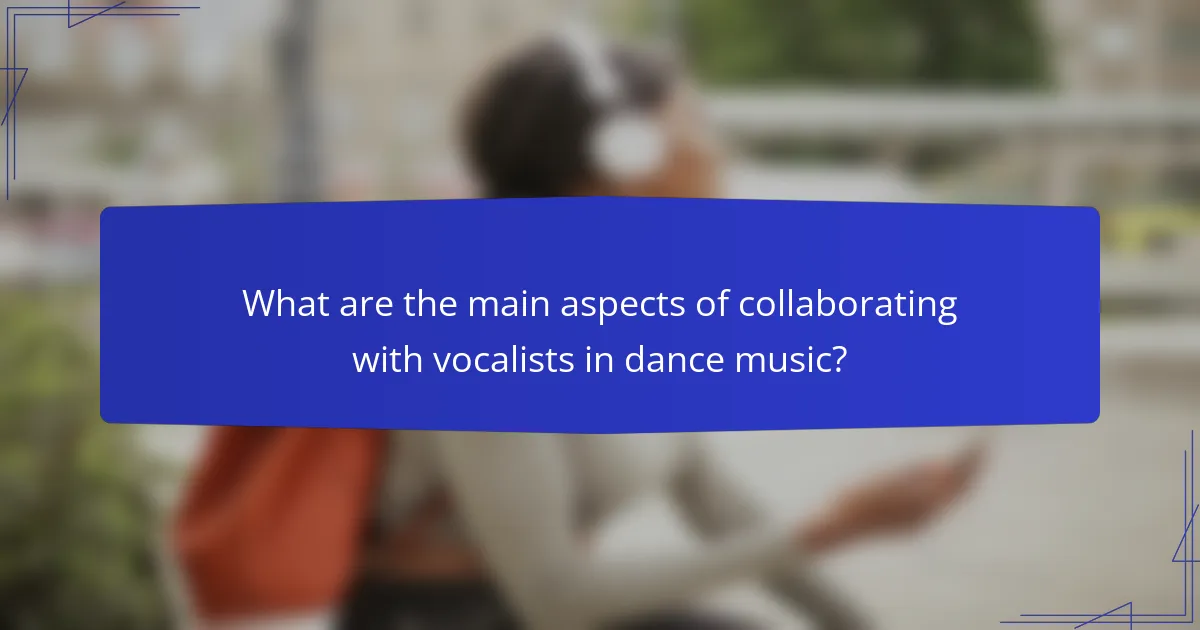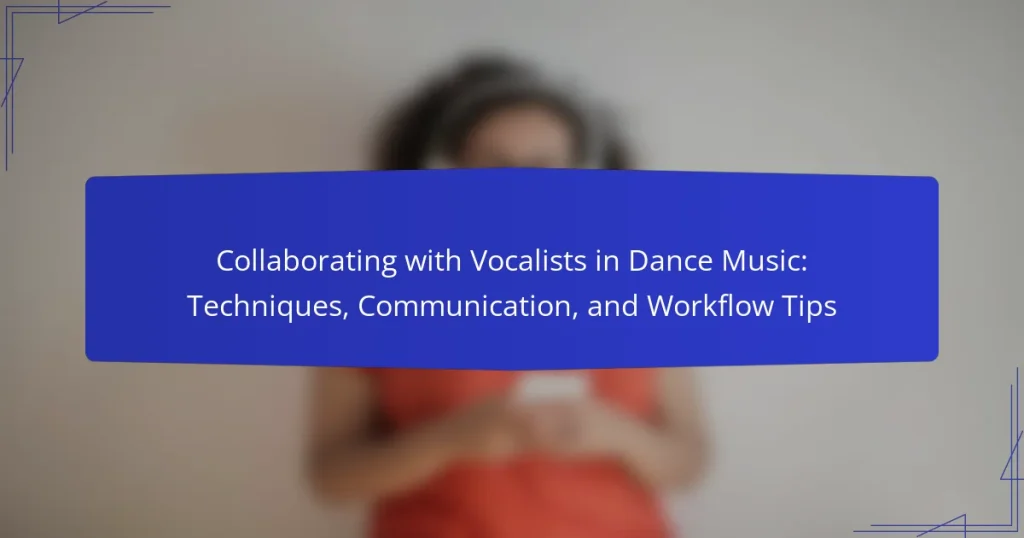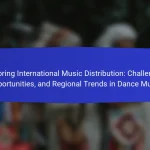Collaborating with vocalists in dance music involves key aspects such as communication, arrangement, and feedback. Effective communication aligns the creative visions of both producers and vocalists, while arrangement focuses on structuring the song to showcase the vocalist’s strengths. Feedback plays a critical role throughout the recording process, ensuring that both parties contribute to the final product. Common challenges include communication issues, creative differences, and technical limitations, which require careful management and open dialogue. Successful collaboration hinges on mutual respect, shared artistic vision, and the use of technology for remote work, ultimately leading to innovative sounds and enhanced audience engagement.

What are the main aspects of collaborating with vocalists in dance music?
The main aspects of collaborating with vocalists in dance music include communication, arrangement, and feedback. Effective communication ensures that both the producer and vocalist share their creative visions. Clear discussions about themes, lyrics, and vocal styles help align expectations. Arrangement involves structuring the song to highlight the vocalist’s strengths. This includes deciding on key, tempo, and the overall feel of the track. Feedback is essential during the recording process. Producers should provide constructive criticism while also encouraging the vocalist’s creative input. Collaboration often results in a unique blend of styles, enhancing the final product. Successful partnerships can lead to innovative sounds and increased audience engagement.
How do vocalists enhance dance music productions?
Vocalists enhance dance music productions by adding emotional depth and engaging melodies. Their voices create a human connection that electronic elements alone cannot achieve. This connection can drive listener engagement and increase the track’s appeal. Melodic hooks from vocalists often become the centerpiece of a dance track. Statistics show that tracks featuring vocals tend to chart higher and receive more airplay. Additionally, vocalists can bring unique stylistic elements that differentiate a production. They contribute to the overall energy of the music, making it more dynamic and memorable. Collaborating with skilled vocalists can also elevate the production quality and professionalism of a track.
What unique qualities do vocalists bring to dance tracks?
Vocalists bring emotional depth and human connection to dance tracks. Their unique qualities include the ability to convey feelings through lyrics and melody. This adds a narrative layer that instrumental music often lacks. Vocalists can also enhance the energy of a track, making it more engaging for listeners. Their vocal delivery can create memorable hooks that encourage sing-alongs. Additionally, vocalists can adapt their style to fit various genres, broadening the appeal of dance tracks. Collaborating with skilled vocalists can elevate the overall production quality. Studies show that tracks with vocals tend to perform better on streaming platforms.
How do vocalists influence the emotional impact of a track?
Vocalists influence the emotional impact of a track through their delivery, tone, and lyrical content. The way a vocalist expresses feelings can evoke specific emotions in listeners. For instance, a powerful, soulful delivery can create a sense of longing or passion. Conversely, a soft, gentle tone may evoke feelings of calm or nostalgia.
Lyrical content also plays a crucial role. Lyrics that resonate with personal experiences can deepen emotional connections. Research indicates that vocal timbre and pitch variations significantly affect listener emotions. A study by Juslin and Laukka (2003) found that variations in vocal expression can lead to different emotional responses from audiences.
Thus, the combination of vocal delivery, tone, and lyrical depth shapes the overall emotional experience of a track.
What techniques are essential for effective collaboration with vocalists?
Effective collaboration with vocalists involves clear communication, active listening, and mutual respect. Establishing a shared vision for the project is crucial. This ensures both parties are aligned on goals and expectations. Providing constructive feedback helps vocalists improve their performance. Encouraging vocalists to express their ideas fosters creativity and innovation. Utilizing technology, such as recording software, streamlines the collaboration process. Scheduling regular check-ins maintains progress and addresses any concerns. Lastly, creating a comfortable environment enhances vocalists’ confidence and performance quality. These techniques facilitate a productive and harmonious working relationship.
How can producers prepare for a vocal session?
Producers can prepare for a vocal session by organizing the session details in advance. This includes selecting the right vocal tracks and ensuring all equipment is functioning properly. Producers should also create a comfortable environment for the vocalist. Providing clear direction and feedback during the session is vital. Additionally, having a reference track ready can guide the vocalist’s performance. Familiarizing oneself with the song’s structure helps in effective communication. Lastly, ensuring adequate time for vocal warm-ups can enhance the session’s productivity. These steps lead to a more efficient and successful vocal recording experience.
What are the best practices for guiding vocalists during recording?
To guide vocalists during recording, establish a comfortable environment first. Ensure the vocalist feels relaxed to enhance performance quality. Provide clear instructions on the desired emotion and style for each section. Use references from similar songs to convey your vision effectively. Encourage multiple takes to capture different interpretations. Offer constructive feedback after each take to foster improvement. Maintain open communication to address any concerns or questions. Utilize visual cues or gestures to guide timing and expression. Consistently check in with the vocalist to ensure they feel supported throughout the process.
What role does communication play in collaborating with vocalists?
Communication is essential in collaborating with vocalists. It ensures clarity of vision and artistic direction. Effective communication fosters a positive working relationship. It allows for the exchange of ideas and feedback. This exchange is vital for achieving desired vocal performances. Clear instructions help vocalists understand the producer’s expectations. Regular check-ins can address any concerns during the collaboration. Studies show that strong communication improves project outcomes in music production.
How can producers effectively communicate their vision to vocalists?
Producers can effectively communicate their vision to vocalists through clear and concise direction. This involves articulating specific ideas about melody, lyrics, and emotion. Producers should use reference tracks to illustrate their vision. Visual aids like mood boards can also enhance understanding. Regular feedback sessions help ensure alignment throughout the process. Open dialogue fosters a collaborative environment. Producers should encourage vocalists to share their interpretations. This two-way communication enhances the final product.
What tools can facilitate better communication during the collaboration process?
Collaboration tools can enhance communication during the collaboration process. Popular tools include Slack, which offers real-time messaging and file sharing. Trello helps organize tasks visually, improving clarity on project status. Zoom provides video conferencing for face-to-face discussions, fostering better understanding. Google Drive allows for collaborative document editing, ensuring everyone has access to the latest information. Asana streamlines project management and task assignments, keeping teams aligned. These tools collectively support efficient communication and project coordination in collaborative environments.
How can workflow be optimized when collaborating with vocalists?
To optimize workflow when collaborating with vocalists, establish clear communication from the start. Define roles and responsibilities for each participant in the project. Use shared digital tools for file management and communication, such as cloud storage and messaging apps. Schedule regular check-ins to discuss progress and address any concerns. Provide vocalists with structured feedback to guide their performances. Create a detailed timeline for recording sessions to ensure efficiency. Utilize templates for song structures to streamline the creative process. These strategies enhance collaboration and improve overall productivity in vocal projects.
What steps can be taken to streamline the recording process?
To streamline the recording process, establish a clear workflow before starting. Define roles for each participant to avoid confusion. Use templates for session setups to save time. Ensure all equipment is tested and ready before recording begins. Organize tracks and label them clearly for easy navigation. Utilize software that allows for efficient editing and processing. Schedule sessions to maximize productivity and minimize downtime. Regularly communicate with vocalists to align on expectations and feedback.
How can project management tools help in managing vocal sessions?
Project management tools can streamline the organization of vocal sessions. They allow for scheduling and tracking deadlines effectively. These tools facilitate communication between producers and vocalists. They provide shared workspaces for collaboration on lyrics and arrangements. Additionally, project management tools help in assigning tasks and responsibilities clearly. They can also track progress and make adjustments as needed. For example, tools like Trello or Asana enable visual task management. This leads to increased efficiency and productivity during vocal sessions.

What are the common challenges faced when collaborating with vocalists?
Common challenges faced when collaborating with vocalists include communication issues, creative differences, and technical limitations. Clear communication is essential to align artistic visions. Misunderstandings can lead to frustration and hinder the creative process. Creative differences may arise regarding song direction or vocal style. These disagreements can impact the final product. Technical limitations often involve recording quality and vocal range. Ensuring the vocalist’s range fits the track is crucial for success. Additionally, scheduling conflicts can disrupt collaboration timelines. These challenges require careful management and open dialogue to overcome effectively.
How can producers overcome vocal performance issues?
Producers can overcome vocal performance issues by implementing targeted techniques. First, they should ensure proper vocal warm-ups to prepare the vocalist’s voice. This can include exercises that focus on breath control and pitch accuracy. Second, using high-quality microphones can capture vocals more clearly. This reduces the need for excessive post-processing. Third, producers can provide a comfortable recording environment. A relaxed atmosphere can enhance vocal performance. Additionally, offering constructive feedback helps vocalists improve their delivery. Finally, using vocal tuning software can correct minor pitch issues during mixing. Research shows that effective communication between producers and vocalists significantly improves performance outcomes.
What strategies can be used to address pitch or timing problems?
To address pitch or timing problems, use pitch correction software and tempo mapping techniques. Pitch correction software, such as Auto-Tune or Melodyne, can adjust vocal pitch in real-time. Tempo mapping involves aligning vocal tracks with the instrumental’s tempo for better synchronization.
Regular practice and rehearsal can also improve timing consistency. Vocalists should familiarize themselves with the song’s structure and rhythm. Analyzing recorded performances helps identify specific timing issues.
Using a metronome during practice can enhance timing accuracy. Additionally, recording multiple takes allows for selecting the best performance. Collaborating closely with the vocalist ensures clear communication about timing expectations.
How can emotional delivery be improved during recording sessions?
Emotional delivery can be improved during recording sessions by enhancing the vocalist’s connection to the material. Encouraging vocalists to visualize the story behind the lyrics can deepen their emotional expression. Providing a comfortable and supportive environment fosters confidence, allowing for more genuine performances. Utilizing vocal exercises and warm-ups can help release tension, leading to a more authentic delivery. Engaging in discussions about the song’s themes helps vocalists relate personally to the content. Additionally, using reference tracks can guide vocalists in achieving the desired emotional tone. Research indicates that emotional engagement in performance enhances listener response, as shown by studies on audience perception of music.
What are the best practices for feedback and revisions with vocalists?
Establishing clear communication is essential for effective feedback and revisions with vocalists. Use specific language when providing feedback to avoid misunderstandings. Focus on particular aspects such as pitch, tone, and emotion. Ensure that feedback is constructive, highlighting both strengths and areas for improvement. Schedule regular check-ins to discuss revisions and progress. Encourage vocalists to express their thoughts and feelings about the feedback. Utilize technology, such as audio recordings, to demonstrate specific points. This approach fosters a collaborative environment and enhances the final product.
How should feedback be delivered to vocalists for optimal results?
Feedback should be delivered to vocalists clearly and constructively. Use specific examples to illustrate points. Focus on the vocalists’ strengths before addressing areas for improvement. This approach fosters a positive atmosphere. Encourage open dialogue to clarify any misunderstandings. Use technical language that is accessible to the vocalist’s experience level. Timely feedback is essential to maintain momentum in the creative process. Studies show that constructive feedback enhances performance and confidence.
What are some common pitfalls to avoid during the revision process?
Common pitfalls to avoid during the revision process include neglecting feedback from collaborators. Ignoring constructive criticism can lead to missed opportunities for improvement. Another pitfall is focusing too much on minor details while overlooking the overall structure. This can result in an unbalanced final product. Additionally, failing to set clear goals for revisions can create confusion. Without specific objectives, revisions may lack direction. Lastly, rushing through the process can compromise quality. Taking time to thoughtfully revise ensures a polished outcome.

What are the key takeaways for successful collaboration with vocalists?
Successful collaboration with vocalists requires clear communication and mutual respect. Establish a shared vision for the project. This ensures both parties understand the artistic direction. Provide constructive feedback throughout the process. This helps vocalists refine their performance. Schedule regular check-ins to discuss progress and address any concerns. This fosters a collaborative environment. Respect the vocalist’s creative input. This can lead to innovative ideas and enhancements. Utilize technology for remote collaboration if necessary. This expands possibilities for working with vocalists worldwide.
What practical tips can enhance collaboration with vocalists in dance music?
Establish clear communication from the beginning. Discuss expectations regarding the vocal style and lyrical themes. Create a comfortable environment for vocalists to express their ideas. Use reference tracks to convey your vision effectively. Provide constructive feedback during the collaboration process. Schedule regular check-ins to assess progress and make adjustments. Utilize technology for remote collaboration, such as sharing files through cloud services. Encourage experimentation with vocal melodies and harmonies to enhance creativity.
How can building rapport with vocalists improve the overall process?
Building rapport with vocalists enhances the overall process by fostering trust and open communication. When vocalists feel comfortable, they are more likely to express their creative ideas. This leads to a more collaborative atmosphere, which can result in better vocal performances. Research indicates that positive relationships in creative settings can improve productivity and creativity. A study by Amabile et al. (2005) highlights that collaboration and rapport significantly enhance creative output. Thus, building rapport can lead to higher quality music production.
What are the most effective ways to ensure a productive session?
Establish clear goals for the session. This ensures everyone knows the desired outcomes. Set a structured agenda to keep the session focused. Allocate specific time slots for each topic to enhance efficiency. Utilize effective communication tools for collaboration. This can include digital platforms that facilitate real-time feedback. Encourage a creative and open environment. This fosters collaboration and idea sharing. Prepare all necessary materials in advance. Having tracks, lyrics, and reference songs ready saves time. Regularly check in with all participants. This maintains engagement and addresses any concerns promptly.
Collaborating with vocalists in dance music is essential for enhancing emotional depth and audience engagement. Key aspects include effective communication, arrangement of tracks, and providing constructive feedback to ensure alignment on creative visions. Vocalists contribute unique qualities that elevate production quality, making the final product more appealing. Techniques for successful collaboration involve establishing clear goals, utilizing technology for project management, and fostering a comfortable environment for vocalists. Addressing common challenges and implementing best practices can significantly improve the workflow and outcomes of vocal sessions.


